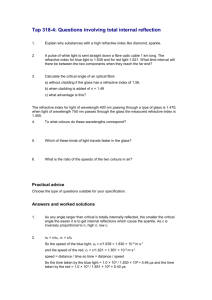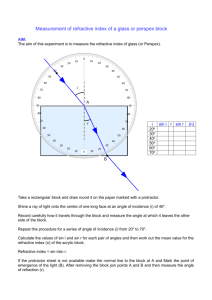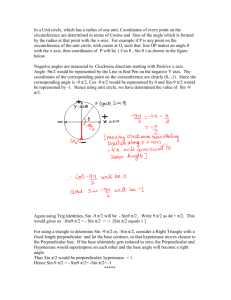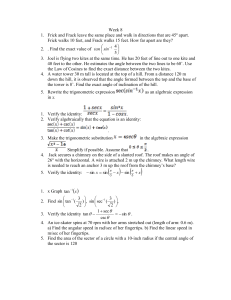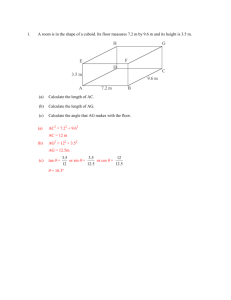These are all the answers to the Physics tutorial questions that I
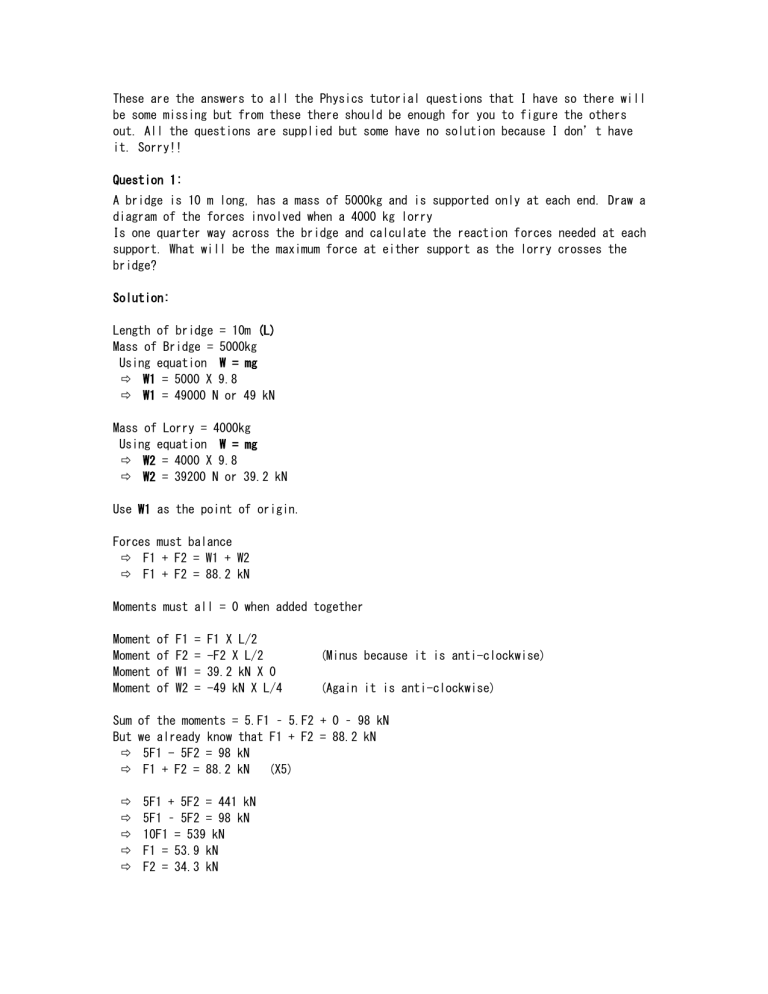
These are the answers to all the Physics tutorial questions that I have so there will be some missing but from these there should be enough for you to figure the others out. All the questions are supplied but some have no solution because I don’t have it. Sorry!!
Question 1:
A bridge is 10 m long, has a mass of 5000kg and is supported only at each end. Draw a diagram of the forces involved when a 4000 kg lorry
Is one quarter way across the bridge and calculate the reaction forces needed at each support. What will be the maximum force at either support as the lorry crosses the bridge?
Solution:
Length of bridge = 10m (L)
Mass of Bridge = 5000kg
Using equation W = mg
W1 = 5000 X 9.8
W1 = 49000 N or 49 kN
Mass of Lorry = 4000kg
Using equation W = mg
W2 = 4000 X 9.8
W2 = 39200 N or 39.2 kN
Use W1 as the point of origin.
Forces must balance
F1 + F2 = W1 + W2
F1 + F2 = 88.2 kN
Moments must all = 0 when added together
Moment of F1 = F1 X L/2
Moment of F2 = -F2 X L/2 (Minus because it is anti-clockwise)
Moment of W1 = 39.2 kN X 0
Moment of W2 = -49 kN X L/4 (Again it is anti-clockwise)
Sum of the moments = 5.F1 – 5.F2 + 0 – 98 kN
But we already know that F1 + F2 = 88.2 kN
5F1 - 5F2 = 98 kN
F1 + F2 = 88.2 kN (X5)
5F1 + 5F2 = 441 kN
5F1 – 5F2 = 98 kN
10F1 = 539 kN
F1 = 53.9 kN
F2 = 34.3 kN
Now the maximum support at either support.
Half the weight of the bridge (W1) + Weight of the vehicle X g
Use F = m.g
(2500 + 4000)kg X 9.8
63700 N or 63.7 kN
Maximum Force at either support is 63.7 kN
Question 2:
A car is travelling at a velocity of 20m/s, when the brakes are applied to give it a constant deceleration of 2m/s . How long will it take to stop and how far will it travel from the point where the brakes were applied?
Solution:
How long will it take to stop?
Initial Velocity,( Vi ) = 20 m/s
Deceleration, ( a ) = -2m/s
Time taken ( t ) = ?
(End Velocity ( U ) is 0)
U = Vi + at
0 = 20 – 2t
2t = 20
t = 10
It will take 10 seconds to stop.
How far will it travel before it stops?
Distance travelled ( D ) = ?
Use equation D = Ut + at
U = 0,t = 10,a = 2.
D = (0 X 10) + (0.5 X 2 X 10 )
D = 0 + 100
D = 100 m
The distance it travels before it stops is 100m.
Question 3:
When a 10 N horizontal force is applied to as block sitting on a table, it just begins to move. If the co-efficient of Friction between the block and the table is 0.17, what is the mass of the block?
F1 (The pushing force) = 10 N
The co-efficient of Friction) = 0.17
F1 = Fr, W = R , Fx = F1 + Fr = 0
Using W = m.g, F = R.
m.g = F/
m X 9.8 = 10/0.17
1.6667m = 10
m = 6kg
The mass of the block is 6kg.
Question 4:
To check the safety of a seat belt, a dummy is used in a crash test. The dummy has a mass of 65kg and is brought to rest from a speed of 12 m/s over a distance of 65cm.
Calculate the average deceleration of the dummy and the average force exerted by the seat belt during the crash?
The answers are
the average deceleration is –110.8 m/s”
the average force exerted is –7200 N
Question 5:
Newton’s Law of Gravitation gives the formula for the force of gravity between two masses. Given that the weight of a 1kg mass on the earth’s surface is 9.8 N, the constant G is 6.67 X 10^-11Nm2(to the power of
–11) and the earth’s radius is 6400km, find the mass of the earth.
Solution:
Radius ( R ) = 6.4 X 10^6 m
Mm (Mass of object on surface) = 1
G = 6.67 X 10^-11 Nm
W = 9.8 N
Me (Mass of earth) = ?
Law of Gravitation - F = G . Me x Mm
(R )
F = W
Me = W.(R )
G.Mm
Me = 9.8 X (6.4 X 10^6)
6.67 X 10^-11 X 1
Me = 4.01408 X 10^14
6.67 X 10^-11
Me = 6.018 X 10^24
Mass of the Earth = 6.018 X 10^24kg
Question 6:
A sleigh is travelling at a steady speed of 10 m/s across a level surface, when it reaches a slope and begins to climb up. Assuming that there is no friction between the sleigh and the snow, what will happen to the potential and kinetic energy of the sleigh? What is the maximum height up the slope which will be reached by the sleigh?
Solution:
P.E = K.E when the sleigh reaches it’s highest point.
Velocity of sleigh ( V ) = 10 m/s
Initial Energy ( Ei ) = P.E = 0.5 X m.(V )
End energy ( Ej ) = K.E = m.g.h
Maximum height
h = (V )
2g
h = 100
19.6
h = 5.1m
Maximum height is 5.1m
Question 7:
A 3m long ladder is leaned against a smooth vertical wall, making an angle of 60 with the horizontal ground. The ladder has a mass of 30kg
And the co-efficient of Friction between the ladder and the ground
= 0.4. Calculate the maximum mass which can be supported at the top of the ladder if it is just about to slip.
Length of ladder (L) = 3m
Friction = Fr = .R
Reaction force from the wall = F1
Weight of the ladder = W1 = 30.g
Weight of object at top of ladder = m = ?
Reaction force from ground = R
R = W1 + W2, F1 = Fr
R = 30.g + m.g, F1 = .R
R = (30 + m)g, F1 = 0.4(R)
F1 = 0.4(30 + m)g
Now to find the moments. There are three to be calculated.
(i) Frx = 3.Cos60
, Fry = 3.Sin60
Frx = 3 X 0.5 , Fry = 3 X 0.866
Frx = 1.5 , Fry = 2.598
(ii) Rx = R.Cos30
, Ry = R.Sin30
Rx = R X 0.866 , Ry = R X 0.5
(iii) W1y = W1.Cos60
To get moments add together relevant ones.
-Fry.L + Ry.L –W1y.(0.5 X L) = 0
Now we have these equations all we have to do is work out, m.
0.4(30 + m)g – 2.598Fr + 1.5R – (W1 X 0.5 X 1.5)
1.5R – 0.75W1 = 2.598Fr
1.5(30 + m)9.8 – 0.75W1 – 2.598 X 0.4(30 + m)9.8
14.7(30 + m) – (0.75 X 30 X 9.8) – 1.04(30 + m)9.8
14.7m + 441 - 220.5 – 305.76 – 10.192m
4.508m = 85.26
m = 18.91
Mass = 18.9kg
Question 8:
A spherical drop of oil, 1mm in diameter, falls on a water surface. The oil spreads out to cover a circular patch of diameter 60 cm. Assuming that the oil spreads out until it forms a layer only one molecule thick on top of the water, estimate the size of the oil molecule.
Initial Volume of Droplet = (Vi) = 4/3.
.r
(Volume of a sphere)
Final Volume of Oil Patch = (Vg) = .r
.h (Volume of a Cylinder)
Size of one molecule = h
Set the two equations off against one another.
.r
.h = 4/3.
.r
3.14 X 0.3 X 0.3 X h = 4/3 X 3.14 X 0.0005 X 0.0005 X 0.0005
0.2826h = 5.2333 X 10^-10
h = 1.85 X 10^-9
The size of one molecule is 1.85 X 10^-9,(10 to the –9).
Question 9:
A 250 gram mass was suspended from an elastic band of cross section 1cm . When the weight was added, the 40cm length increased by 4mm. Find the elastic (Young’s)
Modulus or constant of the elastic band and calculate its length if a 400 gram weight is used.
Solution
Area of cross-section (A) = .r
Weight of object (F) = m.g
Young’s Modulus = Stress = F/A
Strain L/L
Strain = L
L
0.004
0.4
0.01 = Strain
Stress = F
A
0.25 X 9.81
(0.01)
2.4525
0.0001
2.45 X 10^4 N/m
Young’s Modulus = 2.45 X 10^4
0.01
2.45 X 10^6 N/m
Calculate length if a 400 gram weight is hung off the elastic band.
If a 250 gram weight causes a 4mm stretch, what stretch will a 400 gram weight cause?
250 = 4mm
400 = x
Using cross-multiplication
x = 4 X 400
250
x = 6.4
The overall length when a 400 gram weight is added is 406.4mm
Question 10:
The roadway of a suspension bridge is supported by 10 steel cables, each
1 cm in diameter. If the centre cables are 3m long, how much will they stretch when a
20 tonne load is spread evenly over the bridge?
(Modulus of Steel = 2.1 X 10^11 N/m )
Solution
Use same equation, Young’s Modulus = Stress = F/A
Strain L/L
Strain = 10x/3000mm (10x,because there’s 10 cables)
Stress = m.g
.r
20000 X 9.81
X (0.005)
2.5 X 10^9 X 3000 = 2.1 X 10^11
10x
7.49 X 10^12 = 10x
2.1 X 10^11
35.6 mm = 10x
3.56 mm = x
The cables will all stretch 3.56mm
Question 11
The piston of a hydraulic jack has a cross section of area 10cm and is filled with oil to a depth of 20 cm. If the bulk modulus of the oil is
4 X 10^9 N/m , how far will the piston move up when an 800 kg car is taken off the jack?
Use the equation
Bulk Modulus = Bulk Stress = Pressure
Bulk Strain V/V
In this case my method is suspect. The source notes are a bit of a mess.
Let the Pressure = Stress from Young’s Modulus only you must multiply it by the depth of the liquid(i.e the oil).
Stress = m X g X depth of oil
Area
800 X 9.81 X 20
0.1
1.57 X 10^6 N/m
The difference in height is now a simple case of dividing one modulus by the other.
Rise in piston = 1.57 X 10^6
4 X 10^9
Rise = 3.924 X 10^-4 m
The rise in the piston is 0.39mm
Question 12:
Using a cylinder of unknown gas, a balloon was filled to a volume of 1 litre at atmospheric pressure. The gas was at 0 C when it came out of the cylinder but soon warmed to 20 C. Assuming that the pressure inside the balloon is the same as that outside, calculate the volume of the gas after it reached 20 C. Careful weighing showed that the mass of the gas inside the balloon was 1.94 grams. What is the molecular mass of the unknown gas?
Use the equation PV = nRT
P = Pressure in Pascals
V = Volume in m
n = no. of moles
R = The gas constant of 8.31
T = Temperature in Kelvins
P1 = 1 X 10^5, V1 = 1, T1 = (273 + 0)
P2 = 1 X 10^5, V2 = ?, T2 = (273 + 20)
P1.V1 = n.R.T1
P2.V2 = n.R.T2
Seen as ‘n’ and ‘R’ are both constant, they’ll cancel.
Also P1 = P2
V1 = T1
V2 T2
1 = 273
? 293
293 = V2
273
V2 = 1.07
Molecular Mass of the unknown gas
Again use PV = nRT
n = 1 X 10^5 X 1 X 10
8.31 X 273
n = 0.044
1.94g = 0.044 moles of gas X
44g = Molecular mass of unknown gas.
Don’t have the WAVES AND SOUND ANSWERS, i.e – I missed the tutorial or I have misplaced the notes. Probably the latter. Here are the questions anyway and answers but no solutions.
Question 13:
What will be the difference in period of two identical pendulums, if one is at the
North pole where g = 9.83 m/s , and the other is at the equator where g = 9.78 m/s ?
Answer = 0.005 seconds
Question 14:
When the end of a string is made to vibrate up and down at 35Hz, a wave travels along the string. The distance between a peak and the next trough is 0.2m. What is the velocity of the wave? The tension in the string altered so that the wave travels at twice it’s original velocity.
What will be the new wavelength of the wave?
Answers = 14m/s , 0.8m
Question 15:
Sound intensity is often measured in Decibels. What is the approximate range of values normally encountered? (In Notes. Look yourself!!) If a sound has an intensity level corresponding to 95dB, what is the equivalent in W/m ?
(Threshold of hearing = 10^12 W/m )
Answer = 3.16 X 10 W/m
Question 16:
Two loudspeakers separately produce 80 and 85 dB. What will be the sound in Decibels, if both sound together?
Answer = 86.2 dB
Question 17:
Total internal reflection occurs at the glass-air surface. Calculate the critical(smallest) angle of incidence for this to occur in glass of refractive index
1.5.
Solution
Refractive index of Glass = Ng
Refractive index of Air = Na
Use equation n1.Sin
a = n2.Sin
b
Na = 1
Ng = 1.5
Sin b = 90
1.5 X Sin a = 1 X 1
Sin a = 0.66
= 41.8
Critical Angle = 41.8
Question 18:
A light beam is incident on a flat mirror at an angle of 50 to the normal direction to it’s surface. The reflected light then hits another mirror fixed at 90 to the first and is then reflected again. Calculate the final direction of the light.
Solution
From diagram, we see that the angle A = angle B, => they are both 50 .
Then by doing a right-angled triangle we deduce that angle C = 40
B + C + 90 = 180
C = 40
If we apply the reflection in the line theory again, we can say that the angle D = angle C, thus it is also 40 .
So to work out the total Angle of Reflection simply add up all the angles.
Total Angle of Reflection = A + B + C + D
50 + 50 + 40 + 40
Total Angle of Reflection is 180
Question 19:
Light hits the side of a glass fish tank at an angle of 40 to the glass surface and passes through it into the water. Sketch the light path across the glass pane and calculate the angles at which it passes into the glass and water.
Solution
Refractive Index
of Air = 1
of Glass = 1.5
of Water = 1.33
Na = index of Air
Ng = index of Glass
Nw = index of Water
Using equation N1.Sin
a = N2.Sin
b
First we do Air to Glass,
Na.Sin40
= Ng.Sin
0.6428 = 1.5Sin
Sin = 0.429
= 25.4
Now for the Glass to Water,
Ng.Sin
= Nw.Sin
1.5 X 0.429 = 1.33 X Sin
0.6435 = 1.33 Sin
Sin = 0.4839
= 28.9
Angle at which it passes through from air to glass is 25.4
Angle at which it passes through from Glass to Water is 28.9
Question 20:
A 100 mW laser is directed into a 25km length of optical fibre. If the attenuation in the fibre is 0.2dB/km, how much light will be lost along the way?
Answer = 68.4 mW
Question 21:
A sample of radioactive material registers 100 counts/second on a Geiger counter when first measured. One hour later the sample only gives 84 counts/second. What is the half-life of the sample?
Solution
N1 = 100 Counts/Second
N2 = 84 Counts/Second
1 hour = 3600 seconds
N2 = N1.e^( .3600)
84 = 100.e^( .3600)
e^( .3600) = 84
100
ln.e^( .3600) = ln.84
100
-3600 = ln.84
100
-3600 = -0.17435
= 0.0000484 or 4.84 X 10^-5
N = No.e^(-2Thl)
N = No.e^( .Thl)
2
(Thl = Time of half-life)
50 = 100.e^(-4.84 X 10^-5)
0.5 = e^( .Thl)
ln0.5 = ln.e^( .Thl)
ln0.5 = .Thl
Set two equations off against one another.
-0.6931 = 0.17435
3600
14311 seconds
2385 minutes
3.97 hours
Half-life of sample is 4 Hours
Question 22:
Almost all natural Uranium consists of the mass 238 isotope, which is an alpha emitter with a half life of 1.4 X 10^17 seconds. How many alpha particles will produced per second by 1kg of Uranium?
Answer = 1.2 X 10^7 Alpha Particles.
That’s all I have for you. Hope it was somewhat helpful because it took ages to bloody write so it better be some use. Any problems, I’ll see if I can help but remember I didn’t do the subject last year.

